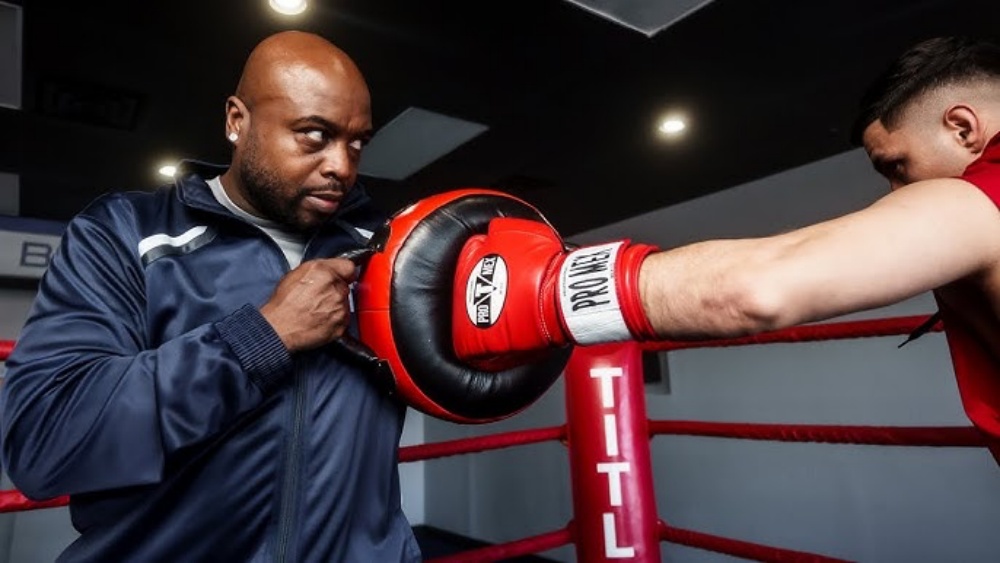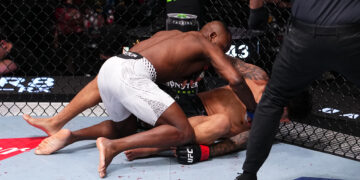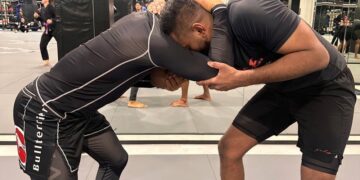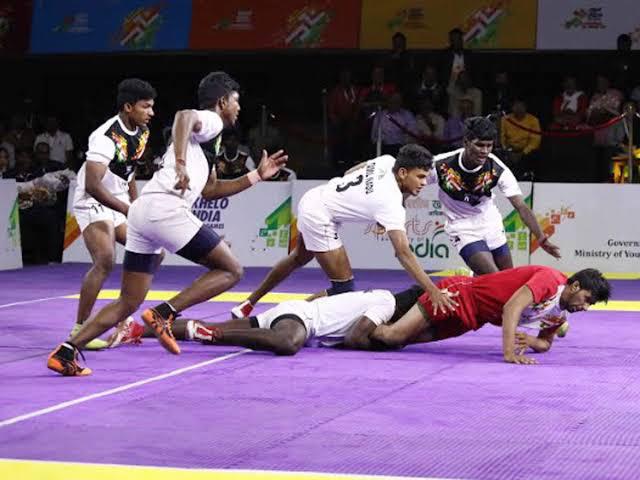
Summary
In boxing, training equipment shapes how a fighter learns and develops. While heavy bags and focus mitts are staples in most gyms, the punch shield has become a favorite among coaches for developing raw power and precision.
A punch shield is a large, padded circular target that coaches hold against their body or at different angles. Because of its thick padding, it can safely absorb hard punches without straining the trainer’s arms. Used correctly, it mimics the feeling of hitting a real opponent while allowing both coach and boxer to move naturally.
Unlike focus mitts, punch shields absorb heavy strikes, allowing boxers to train with full force safely. This guide explains how to use a punch shield properly, its benefits, and drills to include in your boxing sessions.
What Is A Punch Shield?
A punch shield, sometimes called a body shield, is a round, firm pad designed to handle heavy impact. It is thicker than focus mitts and often has handles at the back or sides for the trainer to hold securely.
Unlike the heavy bag, which remains stationary, the punch shield moves with the coach, providing a dynamic target. This movement teaches boxers how to adjust range, control distance, and react in real time, skills that directly translate to sparring or actual fights.
Benefits Of Using A Punch Shield
- Develops Power And Impact Control: Because of its design, a punch shield allows fighters to throw full-power punches safely. Repeated use helps build stronger hips, shoulders, and core muscles, the main sources of punching power.
- Improves Timing And Range: The moving target forces boxers to judge distance and react quickly. Unlike a heavy bag, the shield shifts angles, teaching boxers how to close gaps efficiently.
- Strengthens Defense And Movement: During shield drills, coaches can simulate counterpunches or slips, encouraging defensive movement between strikes. This improves rhythm and defensive awareness.
- Builds Realistic Fight Conditioning: Because shield sessions often involve combinations at fight pace, they improve stamina and replicate the tempo of real exchanges.
How To Use A Punch Shield Safely
- Proper Setup: The holder should grip the shield handles securely, keeping elbows close to the body. This positioning distributes impact evenly through the core and prevents wrist or shoulder strain.
- Control Distance: Boxers should aim to strike from the correct range, extending the arms fully without overreaching. The idea is to land flush with proper form, not to “push” the pad.
- Stay Relaxed And Balanced: Power comes from technique and body rotation, not tension. Relax the shoulders, rotate the hips, and return to stance after every strike.
- Maintain Communication: Good pad work relies on timing between trainer and boxer. The trainer should call out combinations and signal when to reset, ensuring both safety and flow.
Common Mistakes To Avoid
- Overcommitting: Leaning too far into punches can throw the fighter off balance and even create bad habits.
- Ignoring Defense: Many beginners stop moving their head after each punch. Always reset or slip after a combination.
- Punching Without Rotation: Using just the arms limits power. Turn the hips and shoulders for full engagement.
- Standing Still: Both coach and boxer should stay mobile to simulate fight movement and rhythm.
Punch Shield Drills To Try
1) Basic Power Drill
- Start by holding the shield at chest level.
- Have the boxer throws single straight punches (jab, cross) with full power, focusing on form and recovery.
- Repeat for one-minute rounds, alternating hands,
2) Combination Drill
- Call out combinations like “1–2–3” (jab, cross, hook) or “2–3–2” (cross, hook, cross).
- The focus here is to have the boxer maintain fluid rhythm and steps in with each combination.
3) Counter And Defense Drill
- Start by holding the shield for a jab–cross, then push forward as a counter.
- Have the boxer roll, pivot, and execute slips before returning fire with a short combination.
4) Power Flurry Drill
- Have the boxer throw continuous punches for 10 seconds and rest for 10 seconds.
- This builds explosive endurance and conditioning under pressure.
5) Body Shot Drill
- Start by lowering the shield to the body line.
- Have the boxer throw alternating left and right hooks to the body, emphasizing torque and short power.
These drills can be modified for all skill levels, from beginners learning mechanics to professionals sharpening precision.
Training Tips For Better Results
- Warm up before every session to prepare your shoulders and core.
- Keep punches sharp and crisp, not pushed or forced.
- Mix light rounds with power rounds to build endurance safely.
- Use the shield for no more than 3–4 rounds per session to avoid fatigue or strain on the trainer.
FAQs On Using A Punch Shield For Boxing
Q: What Is The Purpose Of A Punch Shield?
A: Punch shield helps boxers train power, timing, and technique safely by providing a mobile, padded target.
Q: Is A Punch Shield Better Than Focus Mitts?
A: They serve different purposes. Focus mitts are for speed and accuracy, while punch shields are designed for power and conditioning.
Q: Can Beginners Use Punch Shields?
A: Yes. Beginners can use punch shields under supervision to learn proper form and control before increasing intensity.
Q: How Often Should I Include Punch Shield Drills In My Training?
A: Two to three sessions per week is ideal for most boxers, depending on training goals and recovery.
Conclusion
The punch shield is more than just a piece of equipment, it is a bridge between technique and real-world application. It trains timing, precision, and power all at once, helping boxers refine every aspect of their game.
Whether you are a beginner or a seasoned fighter, learning to use the punch shield correctly will make your punches sharper and your training more dynamic. It brings fighters closer to the pace, rhythm, and movement of real combat, safely and effectively.
You may also like:
What Is The ‘Offline’ Jab In Boxing?
Summary In the world of boxing, the southpaw stance has always carried an air of mystery. With their right hand and right foot forward, southpaws present a mirror image to most orthodox fighters, forcing opponents…
Summary In boxing, small details often make the biggest difference. While the jab is the most basic and frequently used punch, modern fighters continue to refine it with new techniques and timing. One of the…
Summary The speed bag is one of the most iconic tools in boxing gyms, but it’s often misunderstood. More than just a flashy skill, it develops rhythm, timing, hand-eye coordination, and endurance, which are all…
Every sport has its underdog stories, but in boxing, those moments feel especially powerful. One punch, one night, and one fighter’s belief in themselves can flip expectations upside down. In the modern era, from the…
In combat sports, the way a fighter stands can change everything about how a match unfolds. Stance determines balance, power, and angles of attack. Among the many stances, the southpaw stance is often described as…
Few things in boxing are as intriguing as an orthodox fighter squaring off against a southpaw. The clash of stances often produces unusual rhythms, unexpected openings, and moments of brilliance. Because most fighters grow up…
Summary Deadlifts are often considered one of the most complete strength movements in fitness, but for martial artists, they’re more than just a gym staple. This article breaks down what deadlifting actually is, how it…
Summary In Brazilian Jiu-Jitsu, control always comes before submission. Before you can attack effectively, you must secure a stable position, and the seat belt is one of the best ways to achieve that. The seat…
Summary Stepping onto the mats for the first time can be both exciting and intimidating. You might be ready to learn powerful techniques, improve your fitness, or even test your limits, but martial arts is…
Summary The Central Business District (CBD) is known for its fast-paced work culture, but it’s also packed with great places to eat, unwind, and stay active. Whether you’re looking for a quick lunch, a gourmet…
Summary Takedown feints are one of the most effective tools in modern MMA. By threatening a level change without committing fully, fighters can draw defensive reactions, open striking opportunities, or disguise real takedown attempts. This…
Summary In Muay Thai, every strike has an answer. For low kicks and body kicks, the answer is the check. This simple yet crucial move can change the flow of a fight, turning an opponent’s…



































